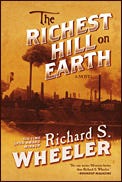Butte, Montana, was known as "the richest hill on earth" during the heyday of the copper kings in the late nineteenth and early twentieth centuries. Here, a few ambitious men could amass fabulous wealth while an unfortunate multitude lived miserably and died young of diseases ranging from miner's lung to syphilis.
In 1892, the Amalgamated Copper Mining Company (later Anaconda) was the biggest copper-producing mine in the world. Its owner Marcus Daly and his rival William A. Clark, a banker, smelter and mine owner, were the two major competitors for the copper wealth in and around Butte until F. Augustus Heinze got in the act. With an inheritance of $50,000, Heinze set himself up as a smelter and then used a legal loophole to extract ore from mines he didn't own.
The characters in The Richest Hill on Earth are all trying to make as much money as they can. Furthermore, journalist J. Fellowes Hall thinks Butte could be "the place for a distinguished newspaper editor to turn himself into a legend." Yellow journalism is the order of the day, and Clark, who wants to be elected Senator, expects Hall to engineer this by slanting his newspaper stories. Heinze relishes his scheming as much as the money it brings in. Butte's undertaker wants better pay for "planting" miners. A fey seeress’s only income is generated by visions of disaster that depress her spirits. A widow tries to scrape together enough to feed herself and her children and avoid freezing in Butte's bitter winters. Although none of these broadly sketched characters are particularly sympathetic, all are probably toned down from the ruthless and/or desperate denizens of copper-era Butte.
Humor lightens an unflinching portrayal of the suffering of the miners and their families, and the novel does reach a qualified happy ending. (2011; 358 pages, including an Author's Note discussing sources and separating fact from fiction)




